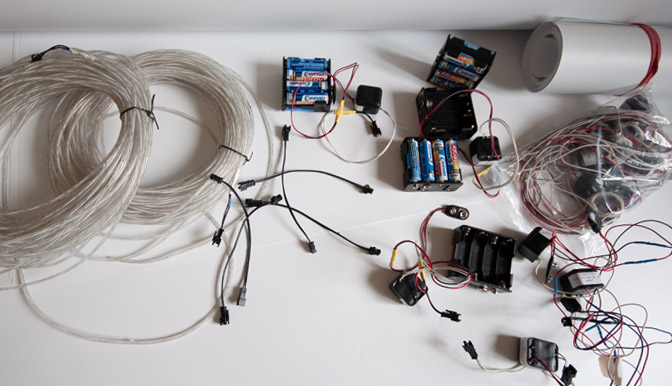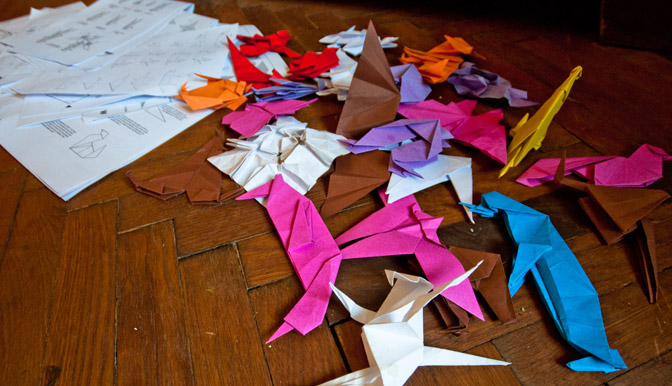:: The MATERIALS
First of all we have to find a proper material for building the sculptures – a kind of paper which is flexible enough to fold, stable enough to stay in a folded position and water resistant enough for outdoor use. Furthermore, the paper has to be the proper size because a very special thing about Origami is that an object is folded out of one single piece of material. We have found our solution in a special PVC paper, 0.2mm thick, 1.41g/cm3 weight and sold in 140x100cm sizes.
The glowing outlines come from an electroluminescent wire. This is a special wire containing phosphor, which illuminates if given electricity. Color and brightness depend on the frequency and voltage. These wires can be bought in different colors, different thicknesses and in nearly any length. We chose the 3mm (diameter) outdoor version in “ice-blue”. Additionally we needed several inverters, adapters, battery packs and some soldering skills to make them finally glow.
 Used materials: EL wires, battery packs, inverters, adapters and the paper.
Used materials: EL wires, battery packs, inverters, adapters and the paper.
:: ORIGAMI FOLDING
Origami (折り紙?, from ori meaning “folding”, and kami meaning “paper”; kami changes to gami due to rendaku) is the traditional Japanese art of paper folding which started (at the latest) in the 17th century AD and was popularized outside Japan in the mid-1900s. It has since then evolved into a modern art form. The goal of this art is to transform a single flat sheet of paper into a finished sculpture through folding and sculpting techniques.
The number of basic origami folds is small, but they can be combined in a variety of ways to make intricate designs. The best known origami model is probably the Japanese paper crane. The principles of origami are also being used in stents, packaging and other engineering structures.
 First we had to make many small models to become accustomed to origami technique and understand how to scale the models to create life-size sculptures. Under the same principles, we were then able to fold these big and unique Origami sculptures.
First we had to make many small models to become accustomed to origami technique and understand how to scale the models to create life-size sculptures. Under the same principles, we were then able to fold these big and unique Origami sculptures.

 Folding, folding, folding,…
Folding, folding, folding,…
 Paper everywhere in the studio… Franzi – our Grand Master of Origami – presenting: “The Bambi”.
Paper everywhere in the studio… Franzi – our Grand Master of Origami – presenting: “The Bambi”.
:: Illumination / El Wire
After the folding procedure was completed, we could start concentrating on the illumination. Different lengths of wire need different inverters for illuminating in the same way (concerning color temperature and brightness). OK! You need maths in real life ; – )
 Testing and experimenting with the effect of the EL wire on the visual appearance of the sculptures. Finding out which edges should be highlighted and which can be or should be disregarded.
Testing and experimenting with the effect of the EL wire on the visual appearance of the sculptures. Finding out which edges should be highlighted and which can be or should be disregarded.

And finally stick the wire on the paper with special glue… Watch out for your fingers – this glue is super fast-drying and super strong!

 POWER ON! The very first sculptures illuminated. EL WIRE ROCKS, ORIGAMI ROCKS! We think it was worth all the hard work. What about you?
POWER ON! The very first sculptures illuminated. EL WIRE ROCKS, ORIGAMI ROCKS! We think it was worth all the hard work. What about you?

